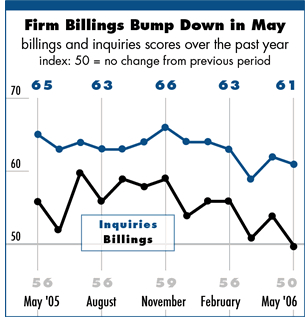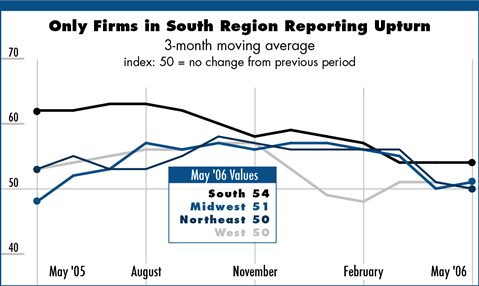

6/2006
Despite recent easing, firms optimistic about compensation growth this year


by Kermit Baker, PhD,
Hon. AIA
Chief Economist
 Architecture firms reported an easing in their billings in May, with
the overall Architectural Billings Index falling below 50 for the first
time since September 2004. Since any reading below 50 indicates a drop
in billings for that month, this score should act as an alert for architecture
firms to monitor project activity more closely in the months ahead.
Architecture firms reported an easing in their billings in May, with
the overall Architectural Billings Index falling below 50 for the first
time since September 2004. Since any reading below 50 indicates a drop
in billings for that month, this score should act as an alert for architecture
firms to monitor project activity more closely in the months ahead.
Given that inquiries for new projects generally remained strong, it is anticipated that overall billings will resume growing in the months ahead. However, the pace of growth of billings at firms has been slowing since the fall of 2005, so it is likely that gains will be increasingly modest in the months ahead.
As the design market continues to adjust, some types of firms will feel the pressure more than others. Larger firms (those with billings of at least $5 million a year) continue to report healthy business conditions and above average inquiries for new projects. Smaller firms (those with billings under $1 million a year) are reporting weak business conditions and only modest levels of inquiries for new projects.
There is comparable variation in business conditions across firms by building sector specialization. Institutional firms (with 50 percent or more of their billings in the institutional sector) have reported a sharp upturn in billings recently and also are reporting strong inquiries. Billings at commercial/industrial firms have not increased as sharply recently, but they are also reporting a strong increase in inquiries. Residential firms, on the other hand, are reporting billings declines and only modest levels of inquiries.
Regionally, with some recent easing at firms in the Northeast and West, only firms in the South are reporting solid growth in billings. Inquiries for new projects are generally healthier at most firms, with strong numbers coming from firms in all regions except the Northeast.
Broader economy slows
In recent months, there have been signs that the broader economy has
begun to slow. Increases in business payrolls averaged only 100,000
in April and May, after increasing by 175,000 per month on average
during the first quarter of the year. Construction payrolls have slowed
even more in recent months.

In spite of threats of a slowdown, the Federal Reserve Board seems more concerned about controlling inflation. More volatile energy costs have pushed up consumer prices in recent months. Prices are beginning to increase, even if you net out food and energy prices. The Fed has sent out signals that it may continue to raise short-term rates in an effort to reign in inflation despite the potential negative effect on the construction industry, housing, and other consumer goods that are interest-rate sensitive.
Though there is little risk of a national economic recession in the coming quarters, growth is expected to slow. A leading indicator for the economy developed by the Economic Cycle Research Institute has been trending down since the beginning of the year. This indicator therefore points to somewhat slower growth in the broader economy in the months ahead. Consumer sentiment, although rebounding slightly with the preliminary June figures, is well below the level it was at this time last year.
 “Reasonably healthy” compensation
rates
“Reasonably healthy” compensation
rates
Even with some easing in business conditions at firms, compensation gains
are anticipated to be reasonably healthy this year. Firms are projecting
increases of 4.4 percent on average for licensed architect positions,
4.2 percent for nonlicensed graduates (not on a licensure track), and
4.0 percent for interns. The increase in base compensation for principals
and partners is projected to be 3.5 percent on average this year.
In terms of nonguaranteed compensation, almost a third of firms expect paid overtime for hourly employees to increase this year, while only 6 percent expect it to decrease. Over half of firms (52 percent) expect bonuses and profit sharing for employees to increase this year, while only 10 percent expect them to decline. Over two-thirds of larger firms (annual billings over $5 million) expect employee bonuses and profit sharing to increase this year, in contrast to less than a third of smaller firms with billings under $250,000.
Copyright 2006 The American Institute of Architects.
All rights reserved. Home Page ![]()
![]()
This month, Work-on-the-Boards participants are saying:
• The friction between the client’s relentless drive to lower or contain
costs and employees wanting raises puts firm management in a painful place.
• Our workload has expanded rapidly while we are having a very difficult
time finding more employees.
• There’s a huge bubble of new work right now, but we’re
also seeing a lot of projects slow down or go away once they reach the pricing
stage.
• Middle-income clients are abandoning residential projects
after schematic design or construction documents when they learn how
high their construction costs will be.
![]()